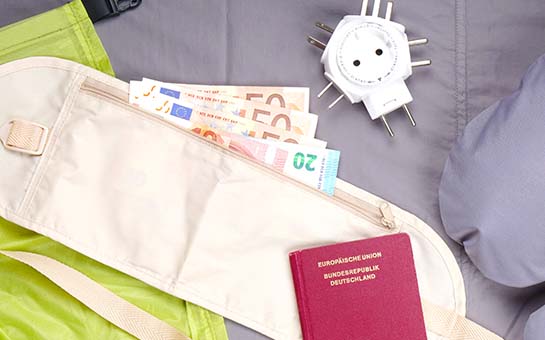Pickpockets are one of the biggest annoyances at tourist attractions the world over. They know tourists congregate at these places, and tourists are guaranteed to have wallets full of cash and credit cards, or purses and hip packs stuffed with valuables that are all too easy to steal. A talented thief can relieve you of some of your most important possessions in seconds, all without you ever knowing what happened. This leaves you stranded in a foreign country, possibly with no cash, no credit cards, and no passport. It’s a real pickle.
Luckily, there is one piece of travel gear that can make a thief’s job a lot harder and protect your valuables much more effectively in public: the money belt.
What is a Money Belt?
Simply put, a money belt is a way to hide your most important possessions in plain sight. Most money belts look like low-profile hip or fanny packs, except they’re typically worn around your midsection on the front of your body, underneath your shirt. Other money belts are like belly bands, also worn under the shirt, but with simple pouches rather than zippered compartments. A third type is an actual belt that you wear like any other belt, except it has hidden zippered compartments on the back with just enough space for folded bills and a credit card or two.
What Features do Money Belts Have?
Although the exact feature set will vary depending on the model and price, money belts are often made of slash-proof fabric to prevent blade attacks, and many have RFID blockers to prevent your credit cards from being scanned. Depending on the design, money belts may have all sorts of secret compartments to stash small items.
Choosing a Money Belt
The right money belt for you depends on what you plan to carry, your body type, and your fashion choices.
If you’re intent on carrying your entire wallet, keys, and phone out of sight, larger fanny pack-style money belts are your only real option. But be mindful of your build and your clothing when choosing one of these. If you’re a small person or your clothes are tight around the midsection it can be practically impossible to conceal a large money belt under your shirt. And there’s no point in wearing a money belt if you can’t conceal it..
If you can get by with only concealing some cash, credit cards, and maybe a passport, the lower-profile band-type money belts can be a better option. They “print” through your clothing considerably less, though the tradeoff is a lot less storage space.
If your only need is to conceal small amounts of cash and credit cards, an actual belt with hidden compartments is the way to go. They’re completely incognito, as they look exactly like a normal leather belt from the outside. However, storage capacity is extremely limited, and they aren’t exactly an option for beach days unless you want to pair a large leather belt with your swimwear.
Money Belt Do’s and Don’ts
Although a money belts can be an extremely effective way to conceal and protect your most valuable possessions on vacation, they only work if you use them appropriately.
- Do: Only put essentials in them. Though some money belts have plenty of room for your sunglasses, sunscreen, and even a guidebook, they’re mighty hard to conceal under a trim-fitting shirt when they’re overstuffed. Only use your money belt for items you can’t afford to lose like cash, credit cards, and your passport.
- Don’t: Access them in public. The whole point of a money belt is concealment. If you’re pulling up your shirt to access your cash while in line at a food truck, you’ve just blown your cover and revealed the location of your valuables to every thief around. If you need to get something from your money belt, do so in a private space like a restroom stall.
- Do: Leave nonessential items at the hotel. Chances are you don’t need every credit card you own, your passport, and all the cash you’ve brought along on the trip for one day. Lock up what you don’t need in the hotel safe. This will keep your money belt more low-profile and prevent you from losing all of your valuables if something happens.
- Don’t: Travel abroad without travel medical insurance or travel insurance. Many insurance plans for travel can offer theft protection benefits, in addition to all sorts of other coverages that can benefit you while traveling internationally. Think of it as an extra degree of safety that even the most eagle-eyed thief can’t spot.

